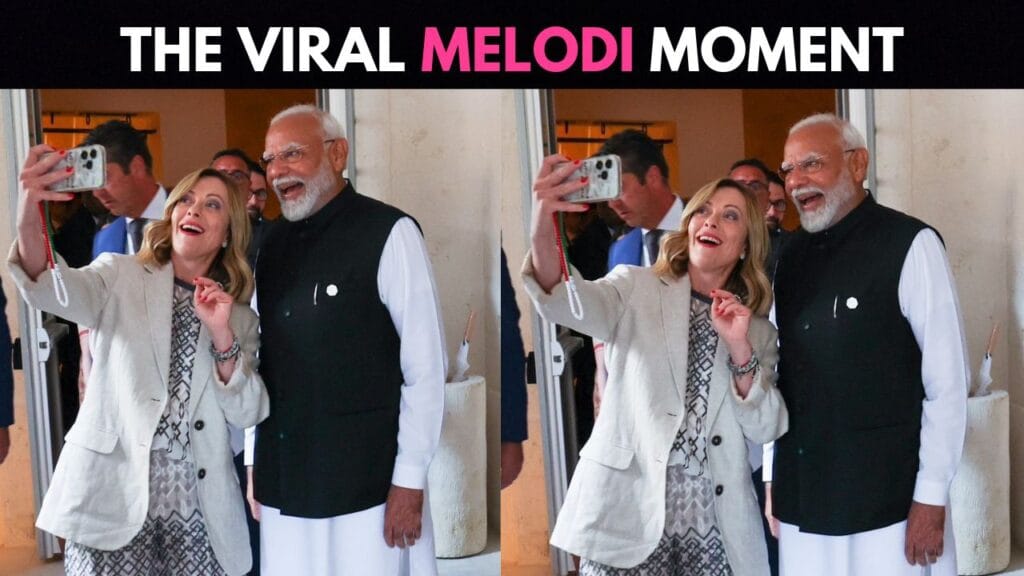Italian Prime Minister Giorgia Meloni is once again in the news, not because of politics or any controversy, but for a much deeper reason. Her way of greeting has become a point of attention across the world. In recent events—whether during her visit to Delhi or her meeting at the White House—Meloni chose not to go for the usual handshake. Instead, she folded her hands with a gentle bow and said “Namaste.” This Indian tradition, which she has repeated on global stages, has made many wonder: is it only a gesture of respect, or does it carry a deeper message? Let’s know more about Giorgia Meloni and her namaste connection.
Giorgia Meloni’s Namaste Diplomacy
Meloni’s most recent “Namaste” moment came during her visit to the White House, where she greeted US Chief of Protocol Monica Crowley with folded hands. In a room full of handshakes and nods, her gesture stood out. It wasn’t the first time either. At the G7 Summit in Italy, she welcomed leaders including UK Prime Minister Rishi Sunak, European Commission President Ursula von der Leyen, and Indian Prime Minister Narendra Modi with the same respectful bow.
The moment was captured on video and quickly went viral, with netizens dubbing it the “Modi effect.” Her warm rapport with PM Modi—highlighted by selfies, social media banter, and the trending hashtag #Melodi—has only amplified the attention.
Strategy Behind the Gesture
Meloni’s use of “Namaste” is more than a friendly wave—it’s a strategic signal. In a post-pandemic world, where physical contact is often avoided, the gesture offers a hygienic and elegant alternative. But beyond health concerns, it’s a way to show cultural sensitivity and global awareness.
India’s growing influence on the world stage, especially under Modi’s leadership, has made its traditions more visible. By adopting “Namaste,” Meloni aligns herself with a rising power while also showcasing her openness to diverse cultures. It’s a soft-power move that resonates with both Eastern and Western audiences.
Diplomatic Bond with India
Meloni’s relationship with India has blossomed in recent years. From shared goals in sustainability and energy to joint appearances at global summits like COP28 and G20, her chemistry with Modi has become a symbol of strengthening ties between Italy and India. Her “Namaste” is not just a greeting—it’s a reflection of that bond.

At COP28 in Dubai, Meloni posted a selfie with Modi captioned “Good friends at COP28, #Melodi,” further fueling the friendly narrative. During the G20 summit in India, edited videos of their interactions—complete with Bollywood music—flooded social media, turning diplomacy into pop culture.
Power of Symbolism
In politics, every move is watched, analyzed, and interpreted. Meloni’s “Namaste” is a subtle but powerful message: one of peace, humility, and cross-cultural respect. It’s a reminder that in a world often divided by ideology and borders, a simple gesture can bridge gaps and spark dialogue.
Whether it’s a nod to India’s traditions, a diplomatic strategy, or a personal choice, Giorgia Meloni’s “Namaste” moments are rewriting the rules of international etiquette—and making headlines along the way.
What Science Says About Namaste
Beyond its cultural and spiritual significance, the gesture of Namaste has intriguing scientific underpinnings. When one performs Namaste—bringing both palms together near the chest—it activates pressure points in the hands that are linked to the eyes, ears, and mind. This is believed to stimulate focus and awareness, making the greeting not just respectful but neurologically engaging.
The gesture is also rooted in the yogic practice of Anjali Mudra, which promotes balance between the left and right hemispheres of the brain. By aligning the hands and bowing the head slightly, the body enters a state of calm and humility, which can reduce stress and foster a sense of connection. In fact, some studies in behavioral science suggest that non-contact greetings like Namaste can enhance interpersonal trust and reduce anxiety in social interactions—especially in post-pandemic contexts where physical touch is minimized.


